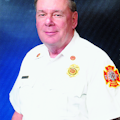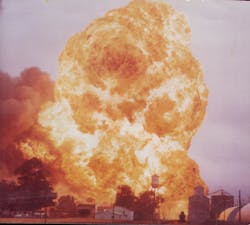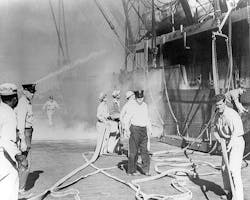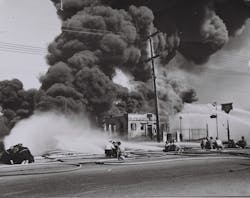Hazmatology: Hazmat Response: History Repeats Itself
Organized hazmat response in the fire service only has been going on for the past 40 years or so. Compared to the history of the fire service, that’s a relatively short time. However, although it wasn’t called hazmat, fire departments have been responding to incidents that involve dangerous chemicals for at least 178 years. Looking back at some of those incidents, it’s surprising how often history repeats itself. It’s even more surprising that we haven’t always learned from incidents that occurred. American theologian Tryon Edwards once said, “Some of the best lessons we ever learn we learn from our mistakes and failures. The error of the past is the wisdom and success of the future.”
Unknown dangers
Dangerous chemicals seem to follow the needs and technology of the time in which they are found. Seemingly one of the earliest incidents involved a gun powder explosion in Syracuse, NY, in 1841.
In the 1800s, dangerous chemicals involved things that were needed for survival, clearing land to plant food crops, hunting, personal protection and entertainment. This included black powder, dynamite and fireworks. There were no regulations that required use permits or that limited places of storage of dangerous chemicals. Anyone could obtain, store and use them wherever and for whatever they wanted. These materials were found in private residences, buildings in business districts and just about anywhere else. Most times, the existence of the dangerous chemicals was unknown to responding firefighters. This resulted in many “accidents” that caused injury and death to both firefighters and the public.
Much of this happened before the advent of radio, television and movies. In those days, when a big fire occurred, the public would turn out in large numbers to watch the firefighters in action. Crowds of people were in harm’s way when explosions occurred with dangerous chemicals, resulting in many citizen deaths and injuries.
The explosion in Syracuse occurred on Aug. 20, 1841, when fire broke out at the Goings Carpenter Shop near the Oswego Canal. Volunteer firefighters in the village responded to the fire. (The Syracuse career fire department wasn’t established until 1871.) Crowds of citizens flocked to the scene. Firefighters didn’t know that the building contained 650 pounds of gunpowder in 25 kegs. An explosion killed upward of 30 people and injured at least another 50. Details of this incident are scarce, and there is no mention of firefighter deaths or injuries. However, given the circumstances, I have no doubt that firefighters were killed and injured.
Throughout the 1800s, incidents such as the one in Syracuse that involved explosives continued to occur.
New chemicals emerge
In 1859, oil was discovered in Titusville, PA. As uses for the oil were discovered, it eventually led to the invention of a plethora of new dangerous chemicals that firefighters would encounter. Today, according to the U.S. Department of Transportation, approximately 50 percent of all hazardous materials incidents involve common petroleum products, such as gasoline and diesel fuel.
During the 1900s, incidents that involved explosive chemicals and petroleum products continued to happen. Although the types of explosives incidents changed, the outcomes were much the same—deaths of citizens and firefighters. Today, it isn’t dynamite or fireworks that typically kill firefighters; ammonium nitrate continues to be a potential problem, primarily because of a lack of general knowledge of its characteristics and hazards. As transportation of dangerous chemicals grew through highway and rail movement, incidents spread to all parts of the country.
Records of the Interstate Commerce Commission (ICC) and the National Transportation Safety Board (NTSB) indicate that hundreds of people were killed in the derailment of passenger trains in the 1800s and 1900s. Then came 1959 and the first documented incident of the release of a dangerous chemical as a result of a train derailment. Known as the Meldrim Trestle disaster, a train derailed from a trestle, above a popular picnic area along the Ogeechee River in Meldrim, GA. Several tank cars of butane fell from the trestle, caught fire and exploded, killing 23 civilians.
Emergency responders attend training programs, and there are national standards that dictate that we be familiar with rail cars, train derailments and incidents that involve the release of hazardous materials. Yet, according to the ICC and the NTSB, only 44 train derailments occurred during which hazardous materials were released from their containers. Most of these incidents, such as the huge explosion that took place at a refinery that’s 90 miles east of Houston, TX, in November 2019, which caused the evacuation or protection in place of 60,000 people, have been career events. The likelihood that any one emergency response organization will encounter a train derailment with the release of hazardous materials is very small. (Many communities don’t even have rail lines in their response area.)
Because emergency responders are faced with such significant demand for training that pertains to everyday duties, hazmat training time is limited. I believe that it would be more prudent to focus major hazardous materials preparation around highway transportation and fixed-facility exposures within response areas. For most of us, those exposures will be about common hazardous materials.
Throughout the 19th and 20th centuries—and into this century—incidents that involve dangerous chemicals (read: hazardous materials and dangerous goods) continued to occur. My research shows that most emergency responders—and the public—are killed and injured by common hazardous materials, which can be found in or shipped through most communities, large or small. Propane, butane, chlorine, anhydrous ammonia, ammonium nitrate, ethanol, crude oil, hydrocarbon fuels and liquefied petroleum gas (LPG), which is a mixture of propane, butane and others, are the major killers of emergency responders—in particular, firefighters.
During the 1940s and continuing to the present day, incidents that involve LPG, propane, butane, pentane, hexane and ammonium nitrate fertilizer killed and injured more emergency responders than all of the other common hazardous materials combined.
On April 16, 1947, in Texas City, TX, ammonium nitrate that was aboard the ship Grandcamp caught fire and eventually exploded, killing 28 members of the Texas City Volunteer Fire Department. On July 29, 1956, a fire at the Shamrock Oil & Gas tank farm in Dumas, TX, killed 19 firefighters and injured many others with serious burns. On Aug. 13, 1963, four firefighters were killed when a propane bobtail truck exploded inside of the Avis Rent a Truck building in Cleveland, OH.Laws and regulations that govern the safe transportation, storage and use of hazardous materials have been slow in development and implementation. They all are reactive, based on a catastrophic hazardous materials release that occurred. For example: Marshalls Creek, PA, was the site of a fire and explosion that involved a transportation vehicle that was carrying 26,000 lbs. of nitro carbo nitrate (the oxidizing ingredient in fertilizer) and 4,000 lbs. of partially gelatin dynamite and blasting caps. The driver of the truck parked the vehicle on the side of the road after it suffered two flat tires, according to reports. He removed explosive signs and placed them in the cab of the truck, disconnected the trailer and went in search of a gas station for help. Firefighters arrived to find the truck on fire. It exploded, killing three firefighters and three civilians. This incident led to a change in federal regulations regarding the marking of vehicles that carry explosives.
On Aug. 18, 1959, a fire that involved above-ground horizontal tanks of gasoline at a service station occurred on the border of Kansas City, KS, and Kansas City, MO. One tank ruptured, and the force of that caused the tank and burning gasoline to overrun firefighters, killing five career firefighters and one civilian firefighter. As a result of this tragedy, regulations were changed to require gasoline storage tanks at service stations that are frequented by the public to be placed underground.That 70s shock
During the 1970s, a string of incidents that involved LPG, propane and butane resulted in catastrophic impact on communities in several states.
On June 21, 1970, in Crescent City, IL, a train derailment resulted in fires and propane tank car BLEVEs (boiling liquid expanding vapor explosions). Fortunately, an Illinois State Police officer who arrived on scene had training in chemical incidents and warned firefighters, who moved back to safer positions before the tank cars exploded. No serious injuries resulted from the incident, but damage to the business district and residential areas was extensive.
On July 5, 1973, in Kingman, AZ, a fire occurred while workers offloaded a tank car of propane. Firefighters responded and set up operations within 100 feet of the burning tank. They used a booster line to attempt to cool the tank. Flames impinged on the vapor space of the tank from the beginning of the fire. A BLEVE occurred. Eleven Kingman firefighters and one civilian were killed; 95 others were injured.
According to the NFPA, at least 500 gpm of uninterrupted flow should be applied to the surface of a burning tank to cool it. NFPA statistics show that pressure tanks can fail from flame impingement within 15–20 minutes of the first flame exposure. It’s estimated that the Kingman fire burned about eight minutes before firefighters arrived and an additional 10 minutes before the first water was applied to cool the tank. It’s estimated that the BLEVE occurred just 19 minutes after the first flame impingement began on the top of the tank.
A train derailment and propane explosion that occurred on Feb. 24, 1978, in Waverly, TN, serves as the high-water mark of hazardous materials incidents in the United States. When the derailment occurred, there were no leaks, no fires, no deaths or injuries. Two days later, an increase in ambient temperature at the scene caused a damaged tank that was being moved without offloading to BLEVE. Sixteen people were killed and more than 43 were injured, including Waverly’s police chief, fire chief and civil defense director. The Waverly incident resulted in numerous changes regarding both tactics for dealing with LPG fires in containers and to safety equipment on railroads.
Some years later, a similar derailment occurred in Weyauwega, WI; the incident commander there used his knowledge of the Waverly incident to formulate tactics. There wasn’t a single serious injury nor death as a result of the derailment. We all can learn lessons from past incidents to protect personnel and the public from harm.
Cognitive information about hazardous materials is what we bring with us to every hazardous materials incident. Cognitive information is what is in the onboard computer that each and every one of us has—our brain. It involves what we have experienced at previous incidents, what we have learned through training classes and what we have learned about what happened in historic hazardous materials incidents.
Because most of us haven’t nor likely won’t experience a large volume of incidents such as those that are noted above, it’s important that we study incidents of the past. We can use the experiences of others to keep us safe when we experience similar situations.
The outcome of many incidents could have been prevented with the appropriate cognitive information. Unfortunately, that information either wasn’t obtained or it was forgotten, and history repeated itself. As recently as September 2018, a 22-year veteran assistant chief was killed in Tilford, SD, in a propane tank explosion.
Although the number of emergency responders who have been killed or injured recently isn’t as large as it was in the past, even one death can affect significantly a department, a community and families.
About the Author

Robert Burke
Robert Burke, who is a hazardous materials and fire protection consultant and who served as a Firehouse contributing editor, is a Certified Fire Protection Specialist (CFSP), Fire Inspector II, Fire Inspector III, Fire Investigator and Hazardous Materials Specialist. He has served on state and county hazmat teams. Burke is the author of the textbooks "Hazardous Materials Chemistry for Emergency Responders," "Counter-Terrorism for Emergency Responders," "Fire Protection: Systems and Response," "Hazmat Teams Across America" and "Hazmatology: The Science of Hazardous Materials."


